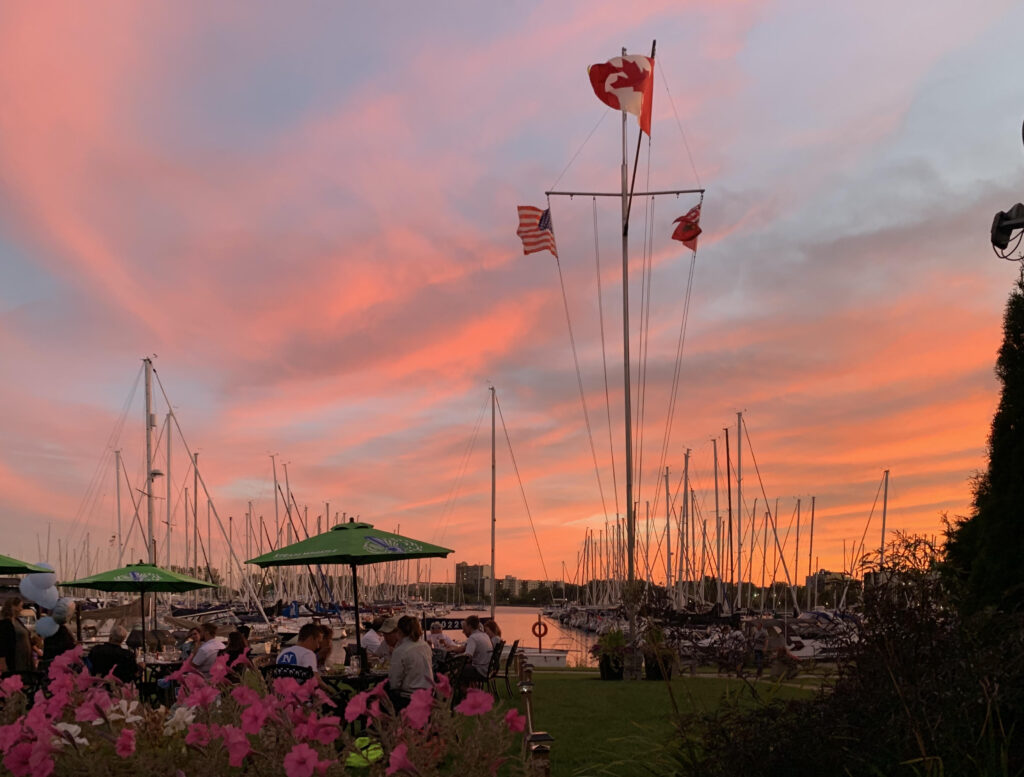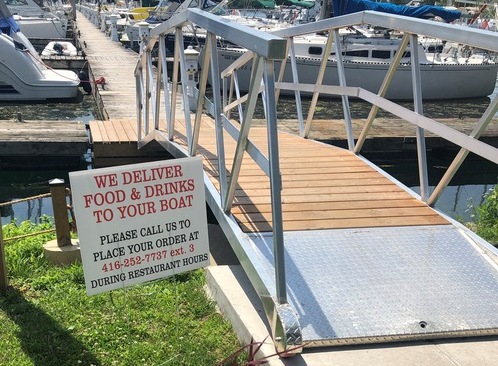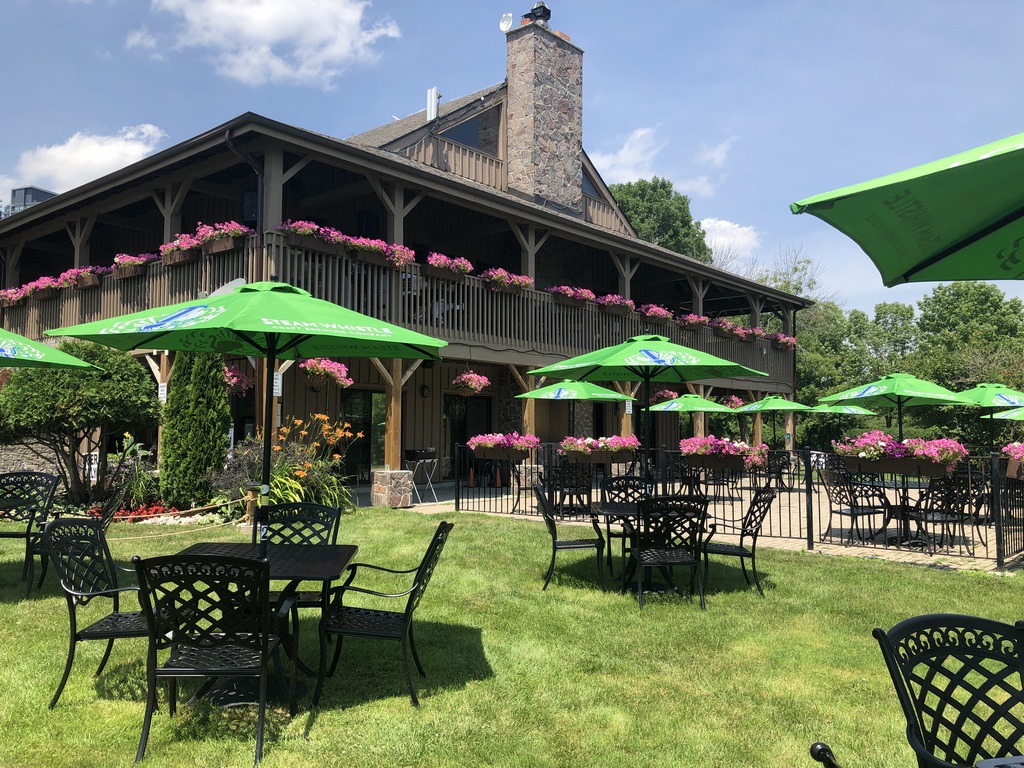Article written by Graham Segger and published in the Jan/Feb 2021 issue of Ontario Sailor Magazine under the byline of Graham Segger, FCPA, MCC Treasurer and Will O’Hara, LLB, MCC Commodore
For many boating clubs and mariners the summer of 2020 was one they would rather forget and quickly place in their wake. Some clubs did not open at all and many boats were stranded on the hard. Just when boaters most needed an escape onto the fair waters of the Great Lakes, they faced a tempest of regulations that often prevented them from doing so. Following is a case study of how one club not only survived, but thrived during the summer of 2020. It will describe how the club carefully navigated the myriad operating rules, regulations and limitations of three different levels of government, all designed to keep everyone safe.
Profile of MCC
First a little information about Mimico Cruising Club (“MCC” or “the club”). MCC is located in Humber Bay West in a protected harbour it shares with Etobicoke Yacht Club and Humber Bay Sailing Centre. Its landlord is the Toronto and Region Conservation Authority with oversight by the City of Toronto. MCC has 306 slips, allocated to Senior A Debenture holders. In addition there are about 100 Social members. Its docks have 27 to 49 foot slips and because the docks are floating, they are not seriously affected by variations in water levels. The sailboat to powerboat ratio is roughly 60:40.
MCC has an experienced full time general manager and supports a restaurant and bar operation through the sailing season, with more limited services in the winter. The ten members of the highly engaged Board of Directors represent a wide array of skills and backgrounds. It is very much a self-help club (21 hours required, less for seniors) with 23 active standing committees consisting of well over 100 volunteers. While its name implies cruising, the club also has a very active sailboat race program with a Wednesday night race series. Many of the members compete successfully in weekend regattas on Lake Ontario.
MCC Members Dining on the Extended patio at Dusk
Photo by Will O’Hara
The Pandemic Strikes
It was shortly after the annual Robbie Burns banquet in January that the pandemic struck. The Board and GM realized early on that it would be essential to focus on the evolving pandemic-related rules being proclaimed by the various levels of government and respond quickly to each change. Club management and members engaged with contacts at both the administrative and political levels and made commitments to strictly abide by all dictates. The club also monitored guidance from the Ontario Sailing Association.
Launch was initially scheduled for April 25, traditionally a herculean single-day process involving two huge fixed cranes, two mobile cranes and volunteers from the more than 220 boats to be launched. Crews are normally organized in a military fashion with team leaders, deputies and dozens of specialized functions. When Ontario declared a State of Emergency on March 17 and limited gatherings to 50 people, the Board held emergency meetings and the Haulout & Launch Committee chair, Bruce Pierce, General Manager John Pereira, Rear Commodore Jerry Jackson and their committee quickly devised an alternate plan that reduced the size of the teams and spread the launch over multiple days. Launch was pushed back and cranes were rebooked, with the hope that launch would be permitted when the date arrived. Then on March 28 Ontario limited gatherings to 5 people and on March 30 closed all communal or shared, private or public, outdoor recreational facilities. It looked like the chance of a successful launch was slipping away and it was again postponed. The club was chasing a carrot on a stick.
MCC also began a series of contingency planning exercises for its finances. In February the Membership Committee was evaluating ten new member applicants. Nine of them withdrew their applications when the severity of the pandemic became evident. Models were developed based on various revised operating scenarios and non-essential spending was curtailed. One project which had been started in March was an $90,000 wholesale replacement of dock ramps (bridges). This was deemed a critical high-water related safety initiative and under Ontario commercial operations rules was allowed to continue to completion.
New High Water Dock Bridge and Take-out Sign
Photo by Anne Wynne
Responding to the Phased Re-openings
The City of Toronto entered Stage 1 of the phased re-opening program on May 19 which allowed recreational facilities to re-commence operations but continued to restrict restaurants to take-out services. The Haulout & Launch Committee and Board dusted off and refined the revised launch plan and re-booked cranes for two weekends straddling the first week of June.
A Chief Medical Officer was recruited from within the membership. Dr. Bjug Borgundvaag, an Emergency Medicine doctor at Mount Sinai Hospital, was uniquely qualified to plan protocols to ensure that members were kept safe and that all required safeguards were implemented and adhered to. This was doubly important this past year. Not only was the club concerned about the health of its members, it also recognized the critical need to be seen by the local community to be doing so. There are thousands of condo dwellers who had bird’s eye views of the club moorings and grounds and some were quick to make noise when they wrongly perceived that rules were not being adhered to. Members were allowed into each of the three main yards in pre-scheduled time slots to get their boats ready for launch. Volunteer members were posted at the gate to control access and ensure that only small numbers of symptom-free members entered the yard.
The decision to launch – even in June – was not met with universal support by the membership. Several members felt strongly that they should be allowed to keep their boats on the hard for the season. They requested a formal vote on launching or staying put on an individual basis. The Board determined that selective launching was not feasible, given the way boats are stored in the yard and launched by the cranes. As the Rear Commodore put it, “cherry picking was just too dangerous”. The Haulout & Launch Committee and Board concluded that an all or none approach was required and, after an informal survey of members, decided to proceed with a full launch. Interestingly, many of the members who were initially opposed to launching acknowledged later in the summer that they were delighted the Board held firm and splashed all boats. Some were concerned, understandably, of what might happen if the crisis worsened.
When Toronto entered Stage 2 on June 24, which allowed sports training but no competition, a number of the race boats began informal “training sessions” on the lake. This was tricky as many boaters will recognize the old maxim that “any two boats on the same course automatically become a race and any three a regatta”. With Stage 3 opening on July 31, the full racing program began. The club decided to limit crew on each boat to a maximum of 4, down from an average of 7 in normal years. Interestingly, with reopening, new member applications flooded in and by September all slips were filled.
On September 19 when Covid infections began to trend upward in Ontario and outdoor gatherings were reduced to 25, the Board and Haulout & Launch Committee decided, in consultation with the Chief Medical Officer, that plans needed to be altered again. Haulout, which had been scheduled for late October, was moved forward two weeks to ensure that all boats would be back on the hard by Thanksgiving. This was done again under the supervision of the Chief Medical Officer.
Reimagining the Restaurant and Bar Operation
General Manager & COO John Pereira ably stick handled his way through the continually evolving restaurant and bar rules throughout the spring and summer. When restaurant operations were restricted to take-out only on March 17, John quickly developed partnerships with several of the online food delivery networks. He implemented an aggressive marketing campaign directed to the members, many of whom live locally, encouraging them to support the club food and beverage take out option. Once the boats were back in the water, John developed a food and drink delivery service to boats, with signs promoting the service prominently positioned at the head of each dock. This was so popular that it will be maintained in future years, pandemic or not. Later in the summer, when indoor gatherings were expanded to 50 people and outdoor gatherings to 100 people, the club took advantage of the patio expansion provisions in the guidelines to expand the patio well out onto the lawn, allowing better than recommended physical distancing of tables. A representative of each table was recorded with name and contact information to allow contact tracing if required, which fortunately it never was. Many members enjoyed the feeling of grass on bare feet and have asked that this arrangement be kept in place.
One blow which the club was unable to avoid was the loss of most of its Special Event revenue such as weddings. This has traditionally been a small but important contributor to the club’s finances and its loss resulted in a significant reduction in monthly revenue. However, the popularity of club dining partially offset the loss of Special Event revenue and gave the members more time in their own club. Food and beverage revenues were also boosted by the closing of the club barbeques at the end of each dock due to local regulations. Another fascinating side note on the pandemic was that the club’s gardening committee was busier than ever and the grounds had never looked as great as they did in 2020.
MCC Clubhouse and Patio / Lawn
Photo by Anne Wynne
The Role of Subsidies and Deferred Payments
MCC was very grateful for the Canada Emergency Wage Subsidy (CEWS) program introduced by the federal government. This subsidy very much achieved its stated objective of keeping employees on the job at the club, despite the significant reduction in club revenues. Without the program the Club would have had to make greater reductions to staff levels and operations. Salaried food and beverage staff who were under-utilized in their normal roles were redeployed during the spring to other building, grounds and moorings-related tasks.
The Board also established an installment payment option for members financially affected by the pandemic which allowed them to pay their summer mooring fees and winter haul out and storage fees over a deferred period.
A New Normal in the Midst of the Pandemic
Throughout the entire summer the smaller club meeting room was closed and the club washrooms were limited to only two individuals at a time. Mask wearing and physical distancing were mandatory when moving through the main clubhouse and on the docks and pathways. Board and Committee meetings were held virtually using the club’s Zoom account.
Mimico Cruising Club opened early to boats from reciprocal clubs and welcomed many boaters who committed to following the strict visitor protocol which was implemented. This was done to encourage cruising generally and also to encourage other clubs to reciprocate for MCC members. The approach worked well. Other clubs began to open as the summer progressed and MCC members had a variety of other clubs to visit. Club cruises, often with ten to twenty boats visiting reciprocating clubs, were suspended for the most part. However, in keeping with the club’s philosophy of making the usual club events happen, even if compromised by the pandemic, a modified Commodore’s Cruise around the Toronto Islands and back was held. It was a wonderful sight to see a long line of sailboats and power boats filing through the Toronto Harbour with MCC burgees proudly flying.
The club also held a modified Sailpast for the same reason – it was a tradition that should be honoured. This past year it was held at the end of the season rather than the beginning and instead of the club boats saluting the Commodore anchored in the lake, the Commodore glided up and down the fairways on the Race Committee boat. As he passed the boats in their slips – colourful pennants flying from their halyards – children lay in wait to blast the Commodore with their water guns. Participating members were given a bottle of Prosecco and a box lunch as part of the celebration. This was an important event for maintaining club spirit.
Lessons Learned
Mimico Cruising Club had some inherent advantages going into the pandemic. It was on a solid financial footing with a relatively full membership with experienced professional management and an engaged volunteer Board of Directors. It also had Committee members with extensive business experience and acumen. Key factors which led to such a successful summer included:
- Early and diligent focus on the rules imposed by the various levels of government and engagement with the authorities to fully understand all obligations
- A Haulout & Launch Chair and Committee with creative responses to unprecedented challenges
- A Board willing to make tough decisions in a rapidly evolving environment and to consider creative ways to keep the club active without contravening the regulations
- An experienced general manager and staff whose continuity was enabled in part by helpful government subsidies
- Effective use of virtual meeting technology to ensure that informed decisions could be made quickly by the Board and Committees
- An ability to adapt the food and beverage operations to the rapidly evolving regulatory environment and identify new opportunities such as the take-out and dock delivery services and expansion of the outdoor patio
- Establishment of the new position of Chief Medical Officer and identification of an outstanding member to fill that volunteer role
- A club layout which supported physical distancing
- A compassionate approach to financial hardships faced by some members
- A supportive membership which provided helpful challenges and input but also supported decisions ultimately taken, and
- Most of all, cooperative members who were aware of their public health obligations and gladly suffered inconveniences to keep their club alive and active.
One final lesson learned was the importance of regular and forthright communications from the Board to the members. The Commodore, other Board members or the General Manager sent email blasts at least once a week as the winds were shifting. They were brief but informative and they kept everyone up to date. These emails were supplemented by the club’s monthly newsletter, Sheet and Shaft, which provided additional information in an engaging way. Members constantly expressed their appreciation for these communications during such uncertain times. Their importance cannot be overestimated.





